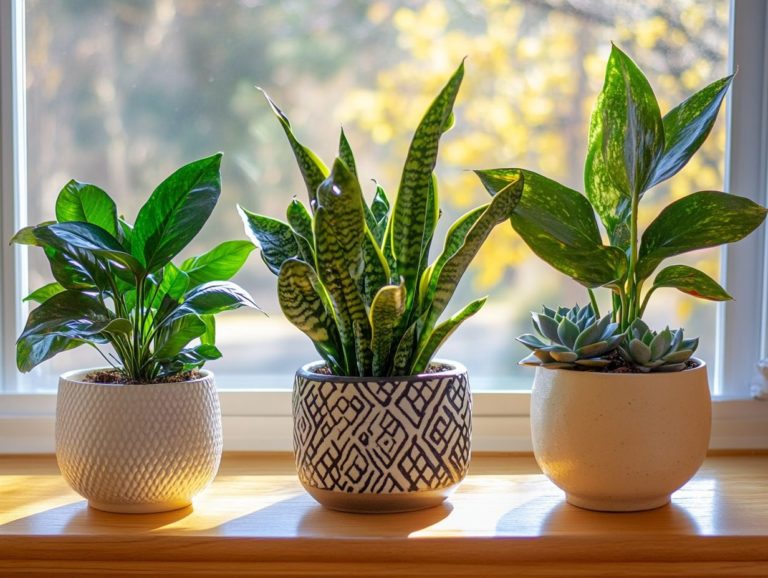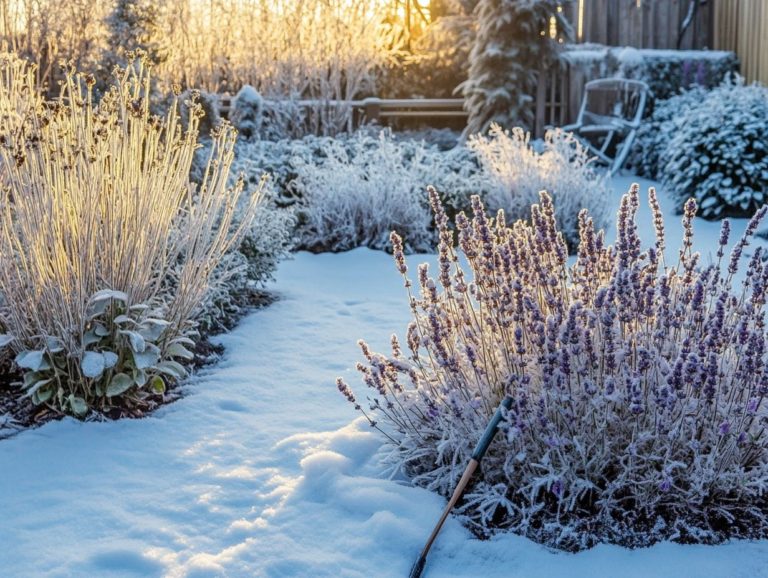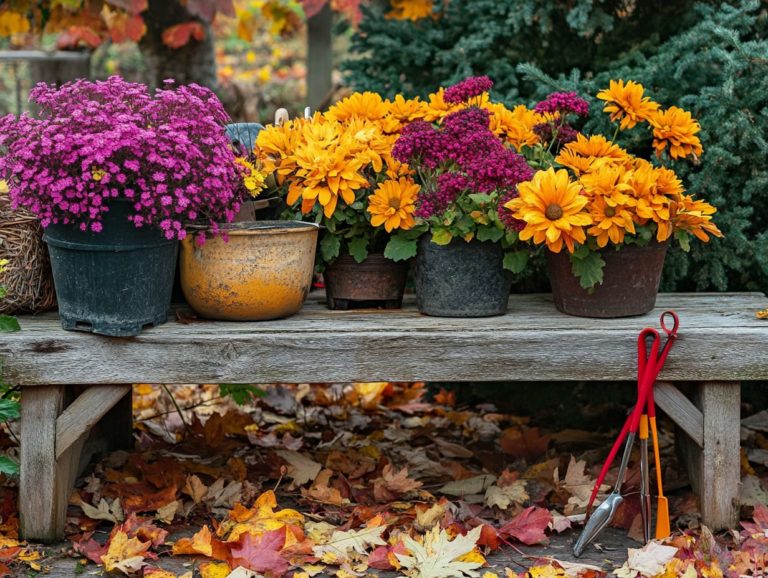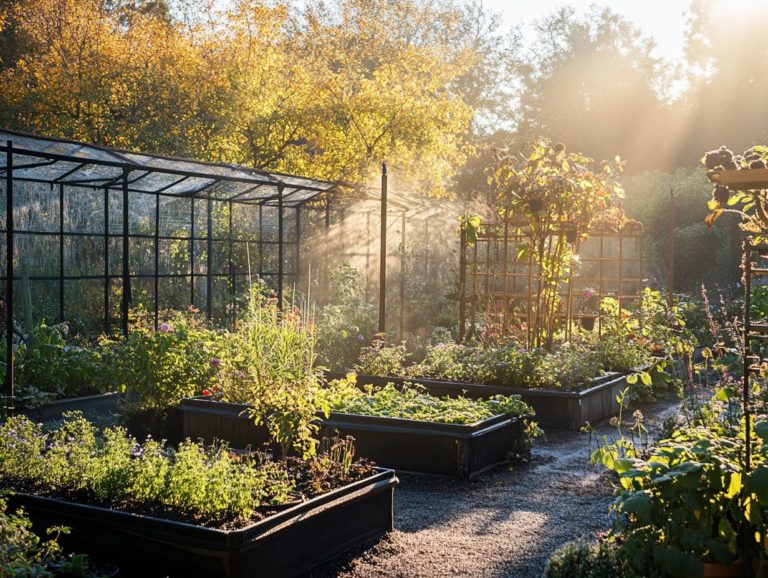Choosing Cold-Hardy Flowers for Your Garden
Gardening enthusiasts understand that choosing the right flowers can truly transform a space, even during the colder months.
Grasping hardiness zones, selecting cold-hardy blooms, and preparing your garden for chilly weather are all essential for nurturing a thriving garden year-round.
This article delves into the top 10 cold-hardy flowers, offers tips on caring for them, and guides you in creating stunning winter arrangements.
Whether you’re a seasoned gardener or just embarking on your horticultural journey, you’ll find valuable insights here to add a vibrant splash of color to your winter landscape.
Contents
- Key Takeaways:
- 1. Understanding Hardiness Zones
- 2. Factors to Consider When Choosing Cold-Hardy Flowers
- 3. Top 10 Cold-Hardy Flowers for Your Garden
- 4. How to Prepare Your Garden for Cold Weather
- 5. Tips for Planting and Caring for Cold-Hardy Flowers
- 6. Common Mistakes to Avoid When Choosing Cold-Hardy Flowers
- 7. Cold-Hardy Flowers for Different Climates and Regions
- 8. How to Extend the Blooming Season of Cold-Hardy Flowers
- 9. Using Cold-Hardy Flowers in Landscaping and Flower Arrangements
- 10. Benefits of Growing Cold-Hardy Flowers
- How to Protect Cold-Hardy Flowers During Extreme Cold Snaps
- What Are the Best Cold-Hardy Flowers for Containers and Hanging Baskets?
- What Are Some Lesser-Known Cold-Hardy Flower Varieties?
- How Can Cold-Hardy Flowers Add Color to a Winter Garden?
- What Are Some Creative Ways to Incorporate Cold-Hardy Flowers in Your Garden?
- How Can You Tell If a Flower is Cold-Hardy?
- Frequently Asked Questions
- 1. What are cold-hardy flowers and why should I choose them for my garden?
- 2. How do I determine if a flower is cold-hardy?
- 3. What are some popular cold-hardy flowers for a garden?
- 4. Can I grow cold-hardy flowers in containers?
- 5. How do I care for cold-hardy flowers in the winter?
- 6. Can I mix cold-hardy flowers with other plants in my garden?
Key Takeaways:
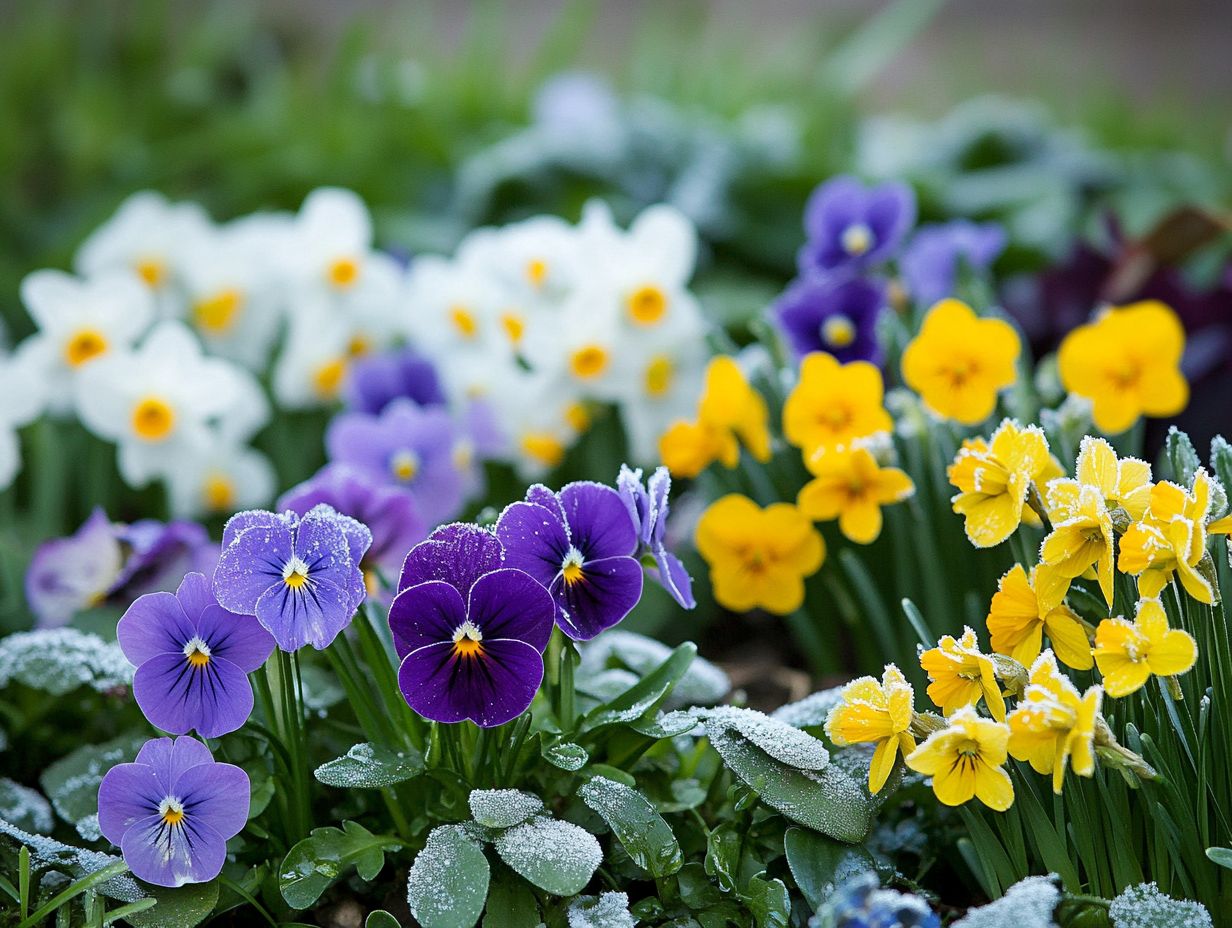
- Understand your hardiness zone to choose flowers that can withstand your climate’s cold temperatures.
- Consider factors such as sunlight, soil type, and water requirements when selecting cold-hardy flowers for your garden.
- Some top cold-hardy flowers for your garden include pansies, tulips, and hellebores.
1. Understanding Hardiness Zones
Understanding Hardiness Zones is crucial for selecting cold-hardy perennials that can weather the harshest winter and thrive in your garden. Familiarizing yourself with the USDA Plant Hardiness Zones helps you pinpoint which flowering plants, like Echinacea purpurea and Heliopsis helianthoides, will flourish in your specific growing conditions.
Experts such as Sheryl Geerts and Denny Schrock emphasize that matching your local climate with suitable native plants is key to maintaining a vibrant and sustainable garden, even in the face of extreme weather events like the polar vortex.
These zones, determined by the average annual minimum winter temperature, are essential guides for your plant selections. A cultivar that thrives in Zone 5 might struggle to survive in Zone 3, highlighting the importance of this classification.
For instance, Astilbe and Coreopsis are fantastic picks for those in warmer regions, while heuchera and sedum are resilient options for harsher climates.
Horticulturists provide invaluable insights to help you navigate these zones effectively. Their expertise can significantly impact your gardening journey, leading to informed decisions that enhance growth potential, promote biodiversity, and ensure that every bloom stands the test of time through the seasons.
2. Factors to Consider When Choosing Cold-Hardy Flowers
When selecting cold-hardy plants for your garden, several key factors come into play. Think about the amount of full sun or part shade your space receives. Ensure you have well-drained soil to support their growth.
Understanding these specific growing conditions is essential for choosing reliable perennials that can flourish, even in the harshest winter weather. Don t forget to consider drought tolerance the ability of a plant to survive with little water and the benefits of using native plants that support local wildlife.
This approach elevates the visual appeal of your garden while enhancing its ecological value. For example, assessing the sunlight requirements of your flowers ensures they receive adequate light, promoting vibrant blooms and overall health.
The quality of your soil impacts water retention and nutrient availability both crucial for developing strong root systems. Selecting plants based on their native characteristics reduces maintenance efforts and fosters a resilient ecosystem.
These thoughtful considerations ultimately contribute to the success of your cold-hardy flowers, transforming your sustainable garden into a thriving habitat for both plants and local fauna.
Don’t wait! Start planning your winter garden now to ensure a stunning display!
3. Top 10 Cold-Hardy Flowers for Your Garden
Get ready to transform your garden with the top 10 cold-hardy flowers that elevate its beauty while ensuring reliable perennials can withstand challenging weather conditions. Favorites like Coreopsis verticillata, with its cheerful yellow blooms, and the aromatic Monarda spp. thrive in colder climates and attract wildlife. For more tips on selecting flowers for a cold-climate border, enhancing your garden’s sustainability, check out our detailed guide.
These resilient blooms play a vital role in creating a vibrant ecosystem by providing essential nectar and pollen for bees, butterflies, and other beneficial insects. Look for the sturdy Echinacea purpurea (coneflower), celebrated for its striking daisy-like flowers and extended blooming period, which typically spans from late summer to fall. It adapts well to various soil types and thrives in full sun, providing shelter for wildlife during harsh winters.
The beloved Helleborus orientalis blooms in early spring and thrives in shaded areas, adding crucial splashes of color to gardens often overlooked during colder months. Horticulturists recommend incorporating a mix of these hardy varieties to create a diverse and resilient garden landscape that stands the test of time.
4. How to Prepare Your Garden for Cold Weather
Preparing your garden for cold weather is essential to ensure reliable perennials can withstand harsh winter conditions and emerge strong come spring. Key practices include mulching, selecting cold-hardy plants, and understanding how winter weather impacts your garden s microenvironment. This approach protects delicate flower varieties and promotes healthier growth.
Start by applying a thick layer of organic mulch like shredded leaves or straw. This not only insulates plant roots but also helps retain moisture in the soil. When choosing plants, look for varieties like asters, sedums, and evergreens that handle low temperatures with ease.
It’s wise to assess your garden s layout and be mindful of frost pockets; planting in these areas needs a careful touch. By taking proactive measures, you will enhance your garden’s sustainability, making it more resilient against extreme cold while fostering a thriving ecosystem for the coming growing season. Start preparing your garden today!
5. Tips for Planting and Caring for Cold-Hardy Flowers
Planting and nurturing cold-hardy flowers requires awareness of their specific needs, such as well-drained soil and optimal placement to unlock their full growth potential. By embracing essential tips and techniques, you can ensure these resilient plants not only survive but truly thrive, enriching your wildlife gardening efforts and contributing to a sustainable ecosystem.
The choice of location is crucial; many cold-hardy varieties flourish in sunny spots with ample air circulation. Enhance drainage by amending the soil with organic matter to help prevent root rot, especially during thaw cycles. Also, adequate spacing between plants is vital, promoting airflow and minimizing the risk of fungal diseases.
Implement methods to keep pests away naturally like attracting beneficial insects or using organic pesticides to keep pesky invaders at bay. Seasonal care, including winter mulching and pruning spent blooms in spring, supports robust health and vibrant blooms throughout the growing season. Start planting and caring for these hardy flowers today for a vibrant garden this spring!
6. Common Mistakes to Avoid When Choosing Cold-Hardy Flowers
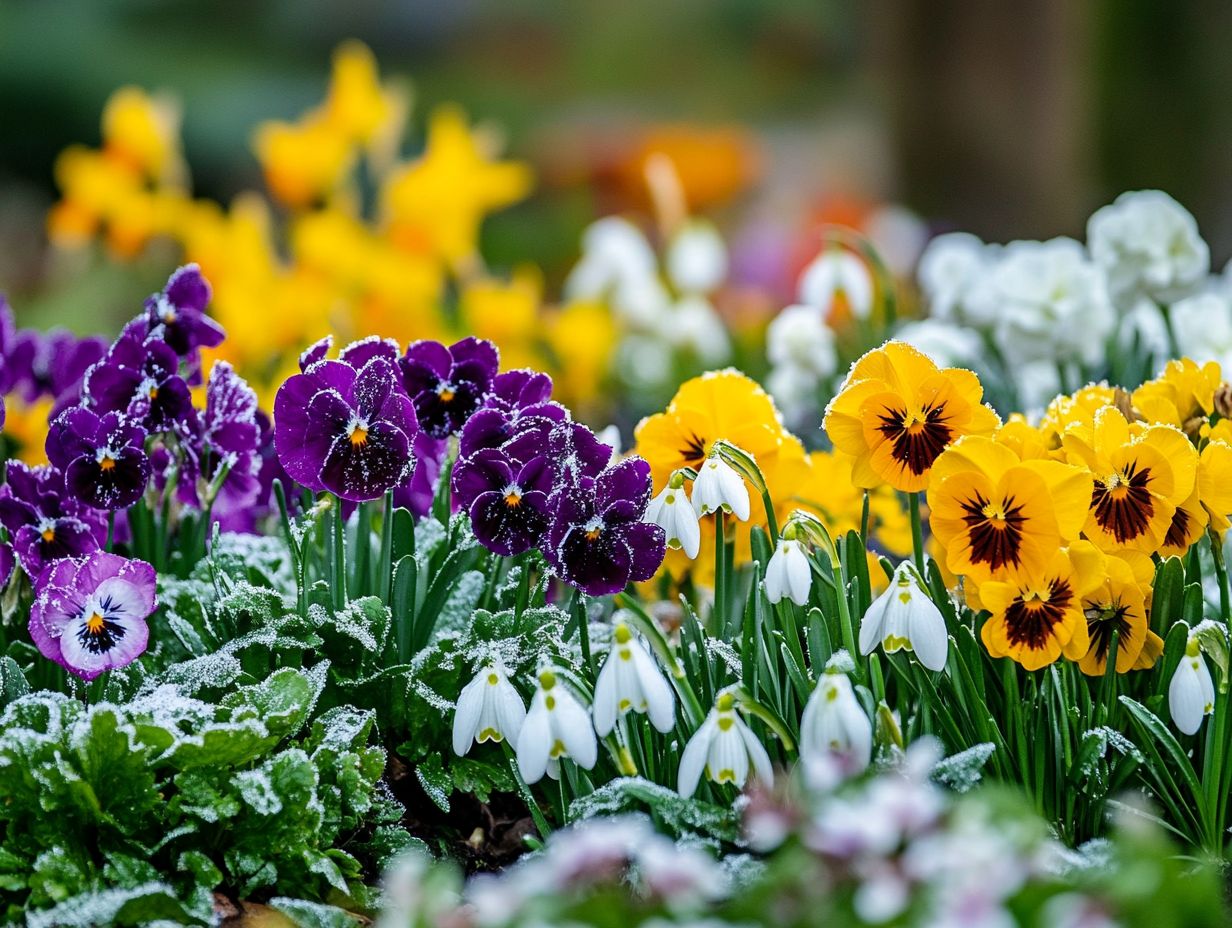
When you’re selecting cold-hardy flowers, be mindful of some common pitfalls that could hinder your gardening success. Understanding the benefits of cold-hardy plants can help you make better choices for your garden.
Choosing reliable perennials suited to your specific climate and soil conditions is crucial. Take the time to learn about native plants; they tend to be your best allies in achieving robust growth.
Many gardeners misjudge plant hardiness, mistakenly believing that certain varieties can endure harsher conditions than they truly can. This often leads to disappointment when those plants just don t thrive.
Planting too many flowers can crowd out valuable resources and reduce airflow, which is vital for growth.
Don t forget about local wildlife! Providing shelter and food for pollinators enhances biodiversity and bolsters the overall health of your garden.
Avoiding these common mistakes will help you create a stunning garden that thrives even in colder climates!
7. Cold-Hardy Flowers for Different Climates and Regions
Selecting cold-hardy flowers tailored to your specific climate and region is vital for cultivating a flourishing garden.
The USDA Plant Hardiness Zones serve as your guide, indicating which plants will thrive under varying conditions. By understanding your local climate, you can make smart choices about flowers that endure seasonal challenges while enhancing your garden’s beauty.
As you assess your garden’s conditions, consider important factors like temperature extremes, moisture levels, and soil type.
In USDA Zones 3 and 4, resilient species like Hellebores and Siberian Iris are excellent options; they flourish in colder temperatures and provide stunning blooms.
If you’re in milder areas like Zones 5 and 6, plants such as Daylilies and Coneflowers add vibrant colors and attract pollinators, enhancing biodiversity.
For Zones 7 and above, hardy varieties like Salvia and Lavender create a lush, fragrant sanctuary that withstands heat, ensuring year-round beauty.
8. How to Extend the Blooming Season of Cold-Hardy Flowers
Extending the blooming season of cold-hardy flowers requires a blend of strategic planning and gardening knowledge to select plants that not only complement each other but also thrive in your unique environment. Techniques such as staggering planting times, choosing reliable perennials celebrated for their long blooming periods, and understanding climatic influences can significantly elevate the visual appeal of your garden throughout the year.
Incorporating a diverse array of flowering plants enhances the aesthetic charm and provides vital food sources for pollinators and other wildlife. By employing targeted planting strategies like grouping plants with similar water and light requirements you can cultivate a sustainable ecosystem that flourishes over time. Consider using native plants for added resilience.
By taking this approach, you can support local wildlife and create a beautiful garden! This thoughtful strategy also minimizes reliance on chemical fertilizers and pesticides, fostering a healthier garden environment. Ultimately, by embracing these practices, you create a vibrant garden that serves as a sanctuary for both flora and fauna, extending the joy of beautiful blooms well into the seasons, regardless of the polar vortex.
9. Using Cold-Hardy Flowers in Landscaping and Flower Arrangements
Incorporating flowers that withstand cold weather into your landscaping and arrangements can infuse vibrant color and texture into your outdoor spaces, ensuring these resilient plants thrive in colder climates. By selecting varieties with colorful foliage and unique blooms, you can craft visually striking displays that are not only aesthetically pleasing but also environmentally sustainable. Consider drought-tolerant options for added resilience.
These flowers add stunning beauty to your garden! When planning your landscaping design, think about blending different flower heights and shapes to create dynamic layers, while also considering seasonal blooms that keep your garden lively throughout the year. Aim for a combination that can survive the coldest winter weather.
Pair robust petals with silvery or green-leaved ground covers for a delightful contrast, ensuring your garden flows naturally. Don t forget to consider the local wildlife; certain cold-hardy flowers attract pollinators, promoting biodiversity and enhancing the environmental health of your outdoor oasis. This thoughtful planting also supports your wildlife gardening efforts.
Don t wait! Start planning your garden now to enjoy beautiful blooms all year round!
10. Benefits of Growing Cold-Hardy Flowers
Cold-hardy flowers provide many benefits beyond just looks. They help create a sustainable garden that supports local ecosystems and wildlife. These resilient blooms not only splash vibrant colors throughout the blooming season but also demand less maintenance and water, making them perfect choices for those seeking to improve the ecological health of their outdoor spaces, particularly when dealing with the challenges of a changing climate.
Beyond their visual charm, these plants attract important pollinators like bees and butterflies, which are vital for biodiversity. Cold-hardy flowers thrive in many conditions and resist pests and diseases better than delicate varieties. This means you ll need fewer chemical treatments. This ability to withstand harsh conditions is especially helpful in extreme weather, like intense cold spells.
They also improve soil health and reduce erosion, creating a stable habitat for diverse flora and fauna. Choosing these hardy flowers helps create a vibrant garden. You ll connect more deeply with nature and enjoy many environmental benefits, especially if you ensure your plants are placed in well-drained soil.
How to Protect Cold-Hardy Flowers During Extreme Cold Snaps
Protecting your cold-hardy flowers during extreme cold snaps is vital for ensuring their survival and resilience against harsh winter weather, which can be a formidable challenge even for the most dependable perennials. By implementing protective measures like mulching, using row covers, and monitoring soil conditions, you can significantly reduce the risk of damage and promote healthy growth come spring.
Prepare your garden before the first frost hits. Timing is crucial! A thick layer of mulch will insulate your plant roots from freezing temperatures, providing a protective buffer. Lightweight row covers are great for protecting delicate blooms from harsh winds and unexpected snowfall. Additionally, regularly checking soil moisture is beneficial; well-drained soil can effectively prevent root rot during fluctuating temperatures, ensuring they can thrive even in challenging growing conditions.
By taking these steps, you can protect your beautiful blooms. Get ready for a vibrant garden when spring arrives!
What Are the Best Cold-Hardy Flowers for Containers and Hanging Baskets?
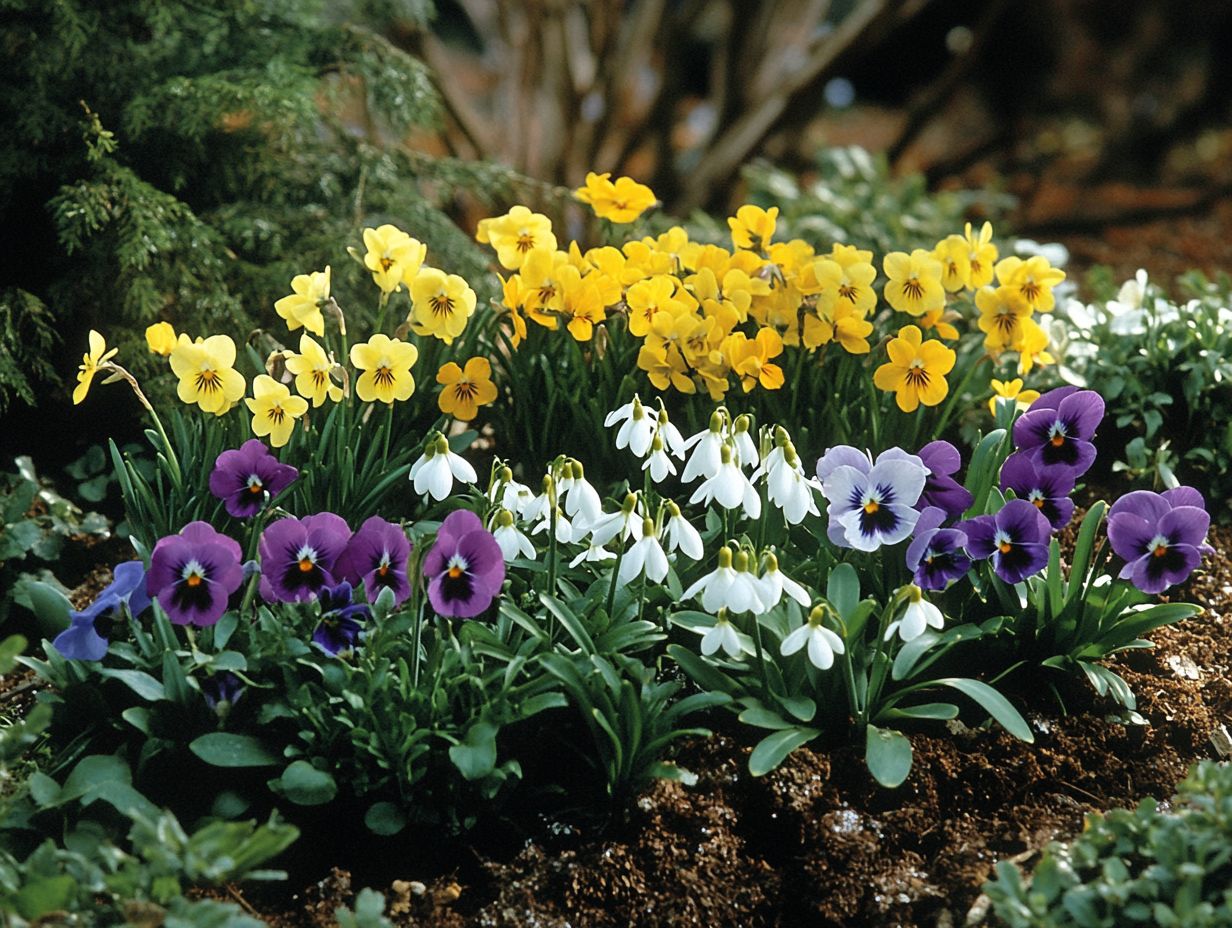
Choosing the right cold-hardy flowers can elevate your outdoor space. Even in cold temperatures, they create a vibrant oasis. The secret lies in selecting plants for a winter garden that handle temperature fluctuations while delivering stunning foliage and blossoms. Options like Helleborus niger (the Christmas Rose) and Viola x wittrockiana provide cheerful yellow flowers that brighten any arrangement.
Consider pansies, for instance. They thrive in cooler conditions, adding a joyful pop to any arrangement. Ornamental kale features eye-catching, ruffled leaves that bring texture and interest. For something different, hellebores, snapdragons, and Hylotelephium spectabile are fantastic options, offering unique forms and textures.
To ensure your plants flourish, proper drainage in your pots is essential. Give them extra care during frost periods and keep up with regular watering. Cold-hardy flowers are versatile; they create visually striking displays, enhancing your balconies, patios, and garden spaces throughout the chilly season.
What Are Some Lesser-Known Cold-Hardy Flower Varieties?
Exploring lesser-known cold-hardy flower varieties can elevate your garden. These unique plants enhance diversity and thrive in different conditions while showcasing your horticultural expertise. Hidden gems like Baptisia and Monarda spp. often surprise with their beauty and adaptability.
By incorporating species like the striking Iris sibirica or the delicate Snowdrop, you can create vibrant displays that thrive even in harsh climates. These flowers attract beneficial pollinators and bloom when many conventional varieties are dormant, ensuring year-round interest.
A commitment to diversity promotes a richer, more sustainable environment, essential for your future gardening endeavors, including the use of native plants.
Don t wait! Start choosing your cold-hardy flowers today to enjoy a vibrant garden all winter long!
How Can Cold-Hardy Flowers Add Color to a Winter Garden?
Cold-hardy flowers will brighten your winter garden, transforming a typically stark landscape into a visually captivating oasis. By selecting the right varieties that bloom in late winter or early spring, you can craft a stunning display that defies the chill of the season, making your garden a true showcase of vibrant colors!
Among these resilient bloomers, varieties like hellebores, winter aconite, and snowdrops emerge early, showcasing delightful shades of white, pink, and yellow that brighten even the dreariest days. Adding elements such as pansies and Viola x wittrockiana, with their cheerful faces and vibrant hues, will further enhance this winter tapestry, creating a truly vibrant display.
Consider layering different heights and textures for visual interest. Taller plants can contrast beautifully with shorter ones, creating depth and intrigue. Incorporating evergreen foliage will frame these colorful blooms, providing year-round structure and ensuring your garden remains lively even in the cold months, particularly through the blooming season.
What Are Some Creative Ways to Incorporate Cold-Hardy Flowers in Your Garden?
Incorporating cold-hardy flowers into your garden design will enhance its aesthetic appeal while ensuring environmental benefits and resilience against the elements. Consider choosing plants for an eco-friendly cold garden to create unique planting arrangements and artful combinations of different varieties. This approach can result in a striking visual impact where your creativity can shine through in countless ways, especially when you incorporate a mix of perennials and annuals!
One effective approach is layering, where taller plants serve as a backdrop for shorter blooms, adding depth and intrigue to your landscape. You can establish focal points by grouping vibrant colors or unique textures that draw the eye, making your garden all the more engaging. Embracing mixed plantings not only enhances beauty but also supports local pollinators and improves soil health, ensuring they can survive during extreme conditions.
The harmonious blend of these cold-hardy flowers can transform your garden into a thriving garden community, brimming with life and color throughout the seasons!
How Can You Tell If a Flower is Cold-Hardy?
Determining whether a flower is cold-hardy requires you to grasp specific characteristics that enable it to flourish in colder climates. Key indicators include its classification within USDA Plant Hardiness Zones (which indicate how well plants can tolerate cold), its growth habits, and its adaptability to local conditions.
To effectively assess cold-hardiness, examine plant tags that can offer valuable insights into the flower’s resilience. Exploring the particular traits of various species will illuminate their capacity to withstand low temperatures.
If you’re seeking expert advice, consulting a horticulturist can provide personalized guidance, enabling you to make informed decisions about which flowers to plant. This comprehensive approach not only boosts your chances of cultivating a successful garden but also contributes to a more vibrant and sustainable landscape when spring arrives!
Frequently Asked Questions
Start planning your winter garden today and bring joy to the gray days ahead!
1. What are cold-hardy flowers and why should I choose them for my garden?
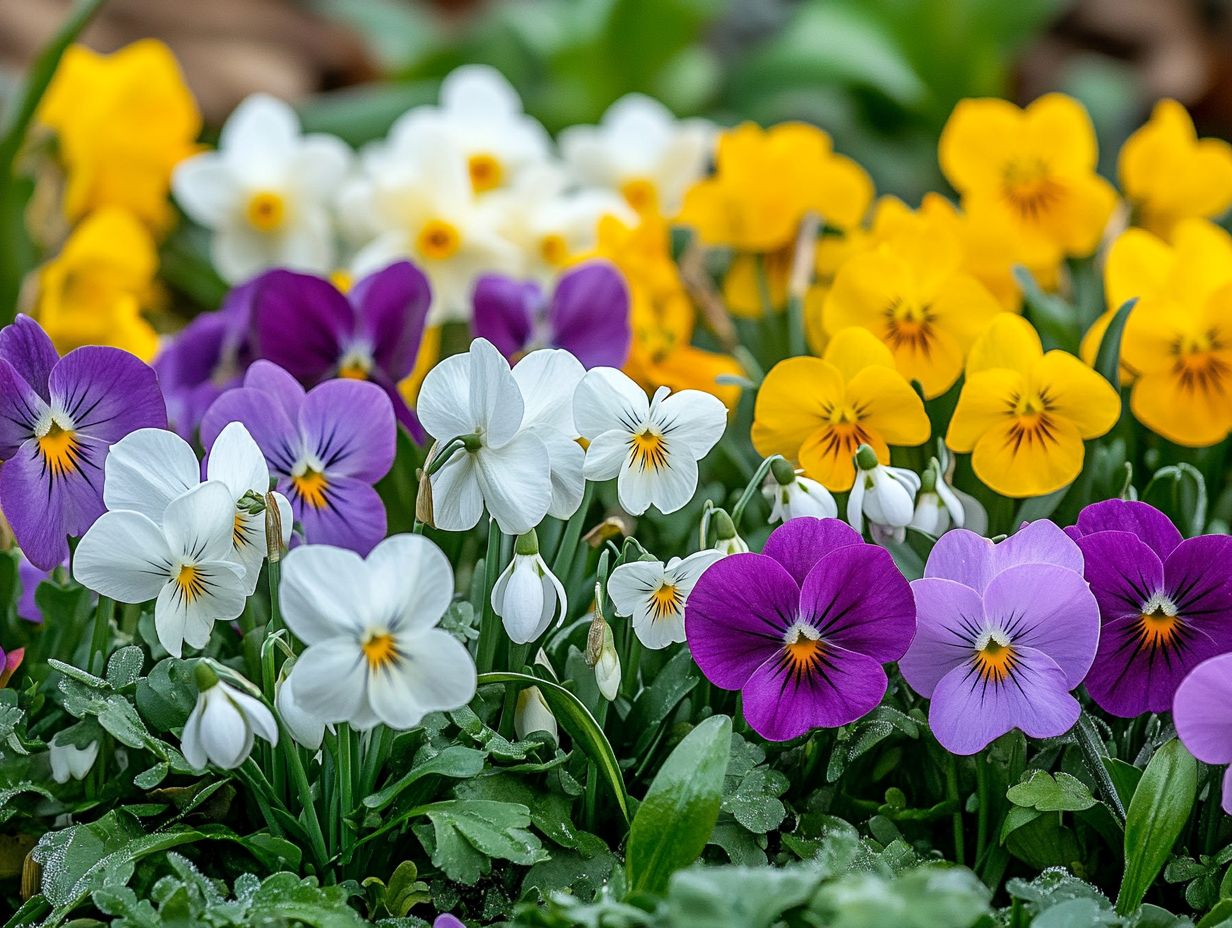
Cold-hardy flowers are plant species that can withstand colder temperatures and harsh weather conditions. Choosing winter blooms for cold climates ensures that your plants will survive and thrive in colder climates.
They provide year-round beauty and color.
2. How do I determine if a flower is cold-hardy?
When selecting flowers for your garden, check their hardiness rating. This rating tells you how well a plant can survive cold temperatures, especially when choosing the right flowers for cold climate bouquets.
Choosing flowers that are rated for your specific zone is crucial for a thriving garden in winter.
3. What are some popular cold-hardy flowers for a garden?
Some popular cold-hardy flowers include pansies, snapdragons, dianthus, violas, and hellebores. For more information on suitable options, consider choosing the right plants for cold climates. These flowers can withstand colder temperatures and come in various colors and sizes to fit any garden design.
4. Can I grow cold-hardy flowers in containers?
Yes, many cold-hardy flowers can thrive in containers, making them a great option for those with limited space.
Get your containers ready and start your cold-hardy garden today! Use a potting mix designed for outdoor use and ensure it has good drainage to prevent root rot.
5. How do I care for cold-hardy flowers in the winter?
Cold-hardy flowers may need some extra care during winter. Mulching around the base of the plants helps insulate the roots.
Covering them with burlap can protect them from harsh winds. Remember to water them regularly, as winter winds can dry out the soil quickly.
6. Can I mix cold-hardy flowers with other plants in my garden?
Yes, you can absolutely mix cold-hardy flowers with other plants for a stunning garden!
Just ensure they have similar growing requirements and leave enough space for each plant to grow without crowding.

